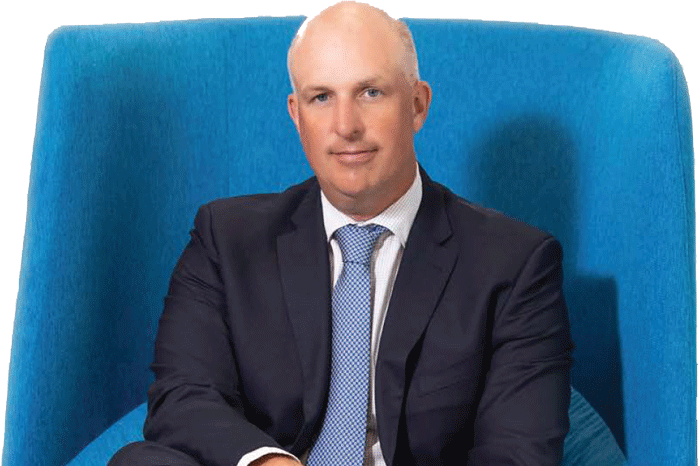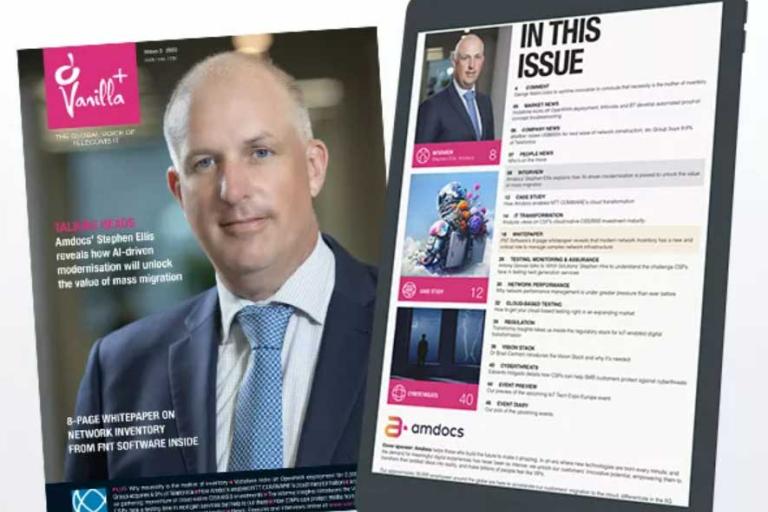This interview first appeared in VanillaPlus.
Communications service providers (CSPs) find themselves in the midst of their transformational journeys towards cloud-native operations, taking varying approaches and moving at varying paces. While it’s crystal clear this move is underway even for mission-critical systems, the destination is not yet within reach.
Increasingly key to this trend are automation and artificial intelligence (AI) technologies, which are beginning to power a range of tools and processes that may radically simplify and accelerate cloud modernization. Yet the current model, where most apps that make it to the cloud are simply rehosted in a lift and shift process, has simply not proven its value.

Stephen Ellis, Amdocs Cloud
Stephen Ellis, the division president and general manager of Amdocs Cloud, recently spoke with George Malim, the managing editor of VanillaPlus, about how CSPs can use automation and AI to redefine their modernization capabilities and their transformations. He also explained how the benefits follow through in acceleration of cloud migration, unlocking true cloud value, and the flexibility to move at the CSP’s desired pace, allowing legacy and on-premise systems to deliver maximized value.
"Mass migration isn’t easy. It’s time consuming and can be expensive"
George Malim: We want to talk about the impact of AI on cloud migration at telcos, but before we get to that, can you give us your view on the current state of cloud adoption and migration among CSPs?
Stephen Ellis: We’re definitely seeing CSPs accelerate their adoption of cloud. That includes both adoption of BSS-OSS cloud-native software and SaaS solutions, as well as modernization and migration of on-premise systems. But is that the whole story? Is it mature? The answer, of course is, ‘No’. We’re only in the middle of the adoption curve and CSPs are still looking to achieve value from their move to cloud. The lift and shift transformation approach, which typified the first years of cloud adoption, has now been largely replaced and we’re seeing a preference for what we term the modernization approach.
On the networking side, it’s still very early. As an industry, we’re still saying ‘if’ rather than ‘when’. Just a few years ago, the same was said about IT moving to cloud and the pivot from ’if’ to ’when‘ occurred extremely fast. I think this will happen here too. Still, even those CSPs who are actively adopting cloud have a huge estate comprising thousands of on-premise apps and workloads. Today’s migration projects are typically small scale and only address tens or maybe hundreds of workloads. And apart from a few exceptions such as AT&T, mass migration simply hasn’t happened yet.
This work still needs to be done. And the lack of scale results in CSPs not always seeing the full benefits of cloud migration.
"Automation in general and AI in particular will be game-changers for cloud adoption, especially for mass migration"
GM: You mentioned that mass migration has not yet happened at CSPs. Why is that?
SE: Mass migration isn’t easy. It’s time-consuming and can be expensive. Thousands of apps need to be evaluated to determine which should be migrated, how, in what order and so on. This requires expertise in cloud, apps and a thorough understanding of the industry you are operating in. After this evaluation, informed decisions will typically determine to leave at least 50% of legacy workloads onpremise, which means they’ll still need to manage data centres, run a large on-premise estate, and support extensive hybrid operations.
Of those workloads that are migrated to cloud, the majority will simply be rehosted, meaning they can’t take full advantage of cloud capabilities such as auto-scale. So sometimes, the cost of running these rehosted apps on the cloud will be more than running them on prem. Certainly, some workloads will be re-platformed and others rearchitected or refactored. But this is the exception rather than rule partly due to the large investment and specific skills needed.
GM: You mentioned rehosting as something that limits the effectiveness of migrations, but I know you foresee a game-changer soon entering the market. Tell us more about this and how it may revolutionize cloud adoption. SE: Automation in general and AI in particular will be game-changers for cloud adoption, especially for mass migration. Without a doubt, integrating AI-driven tooling will transform the migration paradigm, delivering fast, highly automated, accurate, iterative end-to-end processes that support real, mass-scale migration of legacy systems. But beyond just lift and shift, this will increasingly occur via workload modernization, which involves replatforming, rearchitecting and more. It’s this shift in particular that will allow telcos to truly unlock the benefits of cloud. The enabler of all this will be the expedition of app modernization by AI-driven automated processes, which will bring it to a reasonable price point. And while there are already a number of early intelligent and AI-driven tools that can contribute value at certain stages of the modernization and migration process, it’s when they’re all able to be combined into one endto- end process, that it will truly shift the mass migration narrative.
GM: How do you foresee the AI-driven cloud migration working?
SE: AI-driven tooling will automatically scan each workload to create an accurate estimate of the resources and effort to execute the migration effectively. This includes making recommendations for prioritizing specific apps and grouping them in waves that align with the business processes to ensure business operations don’t break down as a result of the migrations. There are already tools that can recommend the “R” for each app and estimate the resources and time needed to migrate apps to the cloud, and then make recommendations on how to break legacy code into microservices and on containerization. But it’s AI-driven tools specifically that will assess the necessary code adaptations and application program interfaces (APIs), while enabling integrations with traditional tools such as ticketing systems. Let’s contrast this with the two different approaches currently in use – either fix your software on-prem before migrating to the cloud, or, if you’re in a rush, migrate first and fix it afterwards. With AI-driven tooling, we’ll be able to automatically identify problems in the software that require fixing before migration, route them to the developers, and have the fixes made in advance. And as the technology matures, more and more fixes will be made automatically either without programmer intervention or with minimal intervention, such as review and approval.
This automated migration won’t all happen in one swoop, at least not initially. It will be an iterative process where AI software scans and rescans apps repeatedly – each time recommending and executing another round of improvements. For example, if you think of the classic three-layer application architecture, it might take several iterations to migrate the full app to the cloud. But when this AI-driven migration vision does become reality, the overwhelming majority of the migration burden will be taken on by software. It really is a brand new paradigm.
GM: What do you see as the main impact of this new era of AI and automation-driven cloud migration?
SE: If you can automate 60%, 70% or even 90% of the workload modernization flow, modernization will become the default migration method. Why rehost when refactoring is automated and rapid? The cloud value CSPs derive will sky-rocket. Also, with automation, multiple migrations can be conducted in parallel, rather than in series. One particularly bold writer recently wrote that the duration of a mass migration project will eventually take the same time currently required to migrate the one most complex app!
I think we’ll also see fewer legacy apps left on-prem. The threshold for migration justification – in terms of effort, time and cost – will be lowered. And because the business case for migration will be easier to meet, we’ll see more workloads moving to the cloud. As a result, CSPs won’t need to dedicate as many resources to maintaining their on-prem estate and hybrid operations, which will allow them to reduce their data center footprint and as a result, costs.
"If you can automate 60% ,70% or even 90% of the workload modernization flow, modernization will become the default migration method"
GM: Can you elaborate on the future prospects and advancements in AI-driven cloud migration technology?
SE: I believe we’re only at the beginning. Companies like Cast and Edge Cloud have already started to execute on AI-driven migration. Over time, we’ll see AI powering more automation, achieving greater accuracy and better results. I’m extremely optimistic about this for the future of CSPs.
GM: And what is Amdocs’ role in this new modernization future?
SE: IT and network cloud migration are currently on the agenda of almost every CSP across the globe, so we’re obviously placing a major focus on those areas. At the same time, we’re remaining at the forefront of AI developments to see how emerging capabilities can be leveraged to create sophisticated technology-driven services.
Beyond that, we offer a comprehensive set of cloud system integration services including consulting, cloud engineering, cloud security, cloud data services, DevOps, organizational enablement, and much more. Importantly though, we also offer cloud operations services. With many of our customers wanting to retain control of their operations, we help them set up their new services, ensure a smooth migration and then return control to them. For those who want us to take full, end-to-end accountability, we’ve also developed a comprehensive model to support them.
Ultimately, there’s no wrong or right approach; it depends on how our customers view cloud and how involved they want to be in the journey. For us, it’s about providing support so that they can modernize at their own pace and budget, and set the level of control and ownership they want – both during the initial transformation journey and as they progress beyond.




